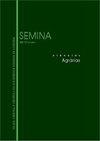Soybean growth and nitrogen accumulation by soybeans in response to desiccation times of Urochloa brizantha pasture and nitrogen fertilization
IF 0.5
4区 农林科学
Q4 AGRICULTURE, MULTIDISCIPLINARY
引用次数: 0
Abstract
The desiccation time of high-biomass pasture and nitrogen (N) fertilization of pasture and soybean can influence the soybean sowing, establishment and growth. The objective of this study was to evaluate how the time of desiccation of the preceding pasture of Urochloa brizantha cv. BRS Piatã, cultivated at three levels of N, and by the soybean N fertilization affect soybean growth and N accumulation. Three N rates (0; 150 and 300 kg ha-1), broadcast as urea on the U. brizantha pasture were evaluated separately in each N level, every one considered as one experiment. In each experiment, five times of pasture desiccation were evaluated (60; 45; 30; 15, and 1 day before soybean sowing) and two levels of soybean N fertilization: 30 kg ha-1 (urea) broadcast at sowing or without N fertilization. A randomized complete block design with five replications was used. Early desiccation of U. brizantha pasture favors the establishment of soybean and promotes an increase in biomass and N accumulation in the vegetative stages, however these differences are not observed during the grain filling, regardless the soybean N fertilization. The soybean yield was not influenced by the desiccation time. N fertilization with 30 kg ha-1 at sowing intensifies soybean growth at the vegetative phase, but after full flowering, there were no effects on biomass and grain yield, independently of the desiccation time.大豆生长和氮积累对乌罗奇洛阿牧场干燥时间和氮肥的响应
高生物量牧草的干燥时间、牧草和大豆的施氮量对大豆的播种、成虫和生长均有影响。本研究的目的是评价毛斑尿藻前牧草的干燥时间如何变化。BRS Piatã,在三个氮水平下栽培,并通过大豆施氮影响大豆生长和氮积累。三个N速率(0;150和300 kg hm -1)作为尿素在大草原上撒播,在每个氮水平上分别进行评价,每个氮水平作为1个试验。在每个试验中,评估5次牧草干燥(60;45;30;大豆施氮量为30 kg hm -1(尿素),播种时施氮或不施氮。采用随机完全区组设计,共5个重复。旱地早期干燥有利于大豆的建立,促进营养阶段生物量和氮积累的增加,但在籽粒灌浆期间,无论大豆施氮量如何,这些差异都没有观察到。大豆产量不受干燥时间的影响。播期施氮30 kg hm -1能促进营养期大豆的生长,但开花后对大豆生物量和籽粒产量无显著影响,与干燥时间无关。
本文章由计算机程序翻译,如有差异,请以英文原文为准。
求助全文
约1分钟内获得全文
求助全文
来源期刊

Semina-ciencias Agrarias
农林科学-农业综合
CiteScore
1.10
自引率
0.00%
发文量
148
审稿时长
3-6 weeks
期刊介绍:
The Journal Semina Ciencias Agrarias (Semina: Cien. Agrar.) is a quarterly publication promoting Science and Technology and is associated with the State University of Londrina. It publishes original and review articles, as well as case reports and communications in the field of Agricultural Sciences, Animal Sciences, Food Sciences and Veterinary Medicine.
 求助内容:
求助内容: 应助结果提醒方式:
应助结果提醒方式:


